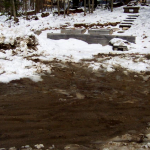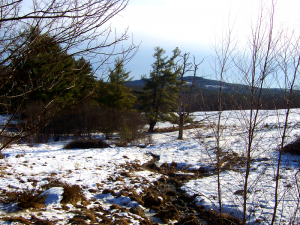
I went to the spring today. Going to the spring is, for me, probably the closest thing I have to going to church regularly. I often go barefoot at the spring, even sometimes in the winter, but in the summer it is truly a delight. The spring is teeming with life; even now in winter there is green visible where the spring water flows from the earth. I always take a moment when I first come to the spring, take a deep breath of the clear mountain air, and pour back some of the water I had carried with me the past few weeks, adding my offering to the rush of spring water flowing forth into the ecosystem. Visiting the spring is a renewal for me, on many levels.
A Spring is a Place
I am lucky to live in Maine where water, in all its forms, is in great abundance. Other places in the world are facing severe shortages of water, and a recent prognosis about a 1000 year drought in the American West is worrisome to say the least. Certainly at the moment, when we have more than 3 feet of snow on the ground, it is easy to see that we are blessed with a tremendous amount of water. Maine has thousands of lakes and ponds, hundreds of swamps and wetlands, and over 3000 miles of coastline on the Atlantic Ocean. But my favorite water in Maine — indeed my favorite water anywhere I’ve yet been on the planet — comes from a particular spring a short distance from my house. This spring is one of the most beautiful places in Maine, and the place feels sacred to me — even more sacred than the other natural corners of Maine. Going there feels almost like a pilgrimage.
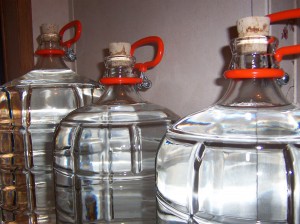
The Hydrologic Cycle, and Water Older than Pollution or Plastic
Each time I go, I gather 20-30 gallons of the most delicious water I have ever tasted, inside the glass containers I bring with me, so that this water I drink will never have spent time encased in plastic. This water is cold, which means it is coming up straight from the aquifer and hasn’t had a chance to warm up by being close to the ground. This time of year, the water is warmer than the ambient temperatures, which is why the spring flows year-round despite the ice and snow. In the summer, there is nothing more refreshing than putting my face under the pipe where 40-degree water flows, on a 90 degree day. Aquifers are the long term “storage bins” for water as it moves through the cycles of the planet. When rainwater falls, it is filtered through the ground as sinks deeper into the earth; aquifers are huge stone containers for water that has been there for centuries, if not millenia — longer than pollution has existed on the planet.
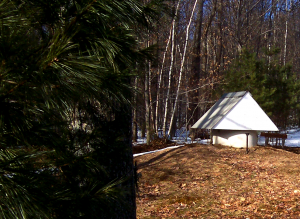
Water has some very peculiar properties that allow it to flow upwards, inside the earth, to the top of the mountain. It collects at the head of the spring, where it then flows into the ecosystem. At the spring I visit, the head of the spring is well-maintained and covered, with gravity-fed pipes that come down to the side of the road where people can conveniently fill up their containers.
There are a lot of reasons to like using spring water. Some of them are health-related. This spring water is almost certainly the cleanest substance I will ever encounter on this planet. When tested with a TDS (Total Dissolved Solids) meter to see how much other stuff is in the water, this water come in at 10 parts per million. This is a very low number — most urban tap water comes in between 75-200ppm. Water is the “universal solvent” and wants to dissolve most things it comes into contact with. But this water is 99.999% pure, or an order of magnitude purer than anything but distilled water (which doesn’t exist in nature, it is artificially created by boiling water and capturing the steam, re-condensing it back to liquid form). This natural spring water is not processed at all, it comes up on its own, a gift from the Earth, pouring forth from the aquifer, up to the mountain, and down a pipe run down to the side of the road.
When Spring Water Isn’t Spring Water…. Because Capitalism
In other words, the water I gather in glass containers from the spring is not what our culture normally thinks of when we think of “spring water.” This term has been accumulated and enclosed by capitalism, we now think of “spring water” as being the good water we can buy inside plastic bottles. Living where I live in Maine, only a few miles from Poland Spring — yep, that Poland Spring — provides a stark contrast between my own relationship with water and that of our culture in general. Poland Spring itself dried up a few decades ago, but the name lives on through the capitalists that trademarked the name, and continue to sell water that people assume comes from the spring it is named after. Incredibly, the legal regulations around what is classified as “spring water” have changed. No more does the term refer to its obvious connotation of water “collected at the point where water flows naturally to the earth’s surface,” but can also mean water extracted “from a borehole that taps into the underground source.”
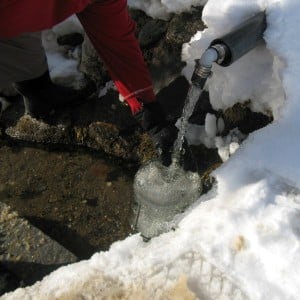
For me, this distinction is critical for several reasons, but at the top of the list is the qualitative, experiential difference between accepting water as a gift, when the Earth is ready to give it on its terms, rather than drilling into her to extract it on our terms, without regard to the effect of large-scale extraction on the ecosystem and the other beings in it.
At my home, we are lucky enough to have good quality well water. It is a definite upgrade from the liquid that flows through pipes in urban areas — ie, water plus whatever other materials are dissolved in it, including trace amounts of legal and illegal drugs, human urine and feces, chlorine, fluoride, and PVC from the pipes it runs through — and I feel blessed to have access to such amazing water for bathing. I don’t mind drinking it either; in my own subjective mind I rate it 9 out of 10 in terms of water quality. But the spring water I gather is 10 out of 10, and it is worth the effort to include it as a central part of my day-to-day life.
The water that we drink is what our blood is made from; within a few minutes of drinking it, the water is in our bloodstream. It makes sense to want to make our blood from the best possible materials we have access to. For me this is the wild spring water that I collect. It is no exaggeration to say that the best wild water of my ecosystem flows through my veins.
Metaphysics of Water
Most traditions associate Water with the direction of West, and use a cup, chalice, or grail as its symbol. These metaphysical associations are well-explored in neopagan literature, so I won’t develop them much here. I will point out that the cup — as a container of water — would be one of the Hallows our ancestors would carry with them, since a way to gather and consume water is essential to surviving in a natural ecosystem.
In addition, the metaphysical associations with water tend to be the realm of emotions and felt experience. These associations do not surprise me, particularly when one looks at the symptoms of dehydration: sleepiness, irritability, dizziness, delirium, heart palpitations, confusion, fuzzy thinking, seizures, and nausea. Is it any wonder that our ancestors then associated Water with emotional experience? These characteristics are even more interesting to me when one considers how widespread they are in our culture, where by some estimates 75% of people are chronically dehydrated.
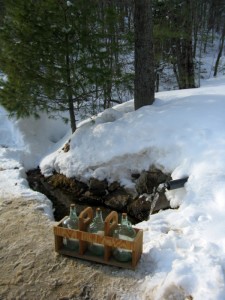
Ideas for Devotional Practices with Water
- Make it a point to attentively drink some wild water on a regular basis. Even if you don’t go to the extent I have, where 95% of what I drink is spring water I gather myself, or a drink (usually coffee, tea, or mead) that I make from this spring water, it is incredibly meaningful to take water into your body that comes from the ecosystem and not from the infrastructures of civilization. This practice will be much more challenging for some ecosystems, such as a desert, than others. Wild water can be collected rainwater or melted snow (which are not likely to require treatment before you drink it), or freshwater collected from a stream or even a lake near where you are. Note that this sort of collected wild water, that doesn’t come up directly from an aquifer and has been at ground level for some time, will likely need to be purified beforehand. Boiling water for one minute or more will kill any critters inside it and make it safe to drink. You might also benefit from filtering the water, to get silt or other materials out of it and improve the taste. There are also handy water purification devices that provide such filtering, allowing you drink as if from a straw directly from the wild source of water. Salt water should never be consumed without desalination.
- Collect some wild water, and store it as-is in a small glass bottle. This is not for drinking, but rather keep it in a mindful place in your home that you visit regularly. If you have an altar, keep it there, preferably on the western edge (or whichever direction you associate with the element of water). Think of this wild water as a filter and a battery to store emotional energy. If you are feeling a strong emotion, project the emotion into the water. Periodically — once a week, or perhaps each moon cycle — offer the water back to the ecosystem, taking the stored emotional energy with it, and refill the container with fresh water. This process is symbolic, and allows another layer of emotional engagement with the ecosystem.
- For a period of time — again, perhaps a week or a moon cycle — keep careful track of how much water you are drinking, and make sure you stay well hydrated. For most people this will mean about 1/2 to 3/4 gallon of water per day, though I often drink more (about a gallon per day). Keep a record of any correlation between how much water you are drinking with your emotional experience each day.










